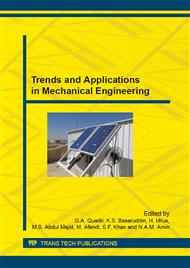[1]
E. Y. Chen, L. Lawson, M. Meshii, The effect of fatigue microcracks on rapid catastrophic failure in Al–SiC composites, Mater Sci Eng A. 200 (1995) 192–206.
DOI: 10.1016/0921-5093(95)07009-5
Google Scholar
[2]
M. Sasaki, L. Lawson, M. Meshii, Low-cycle fatigue properties of a SiC Whisker reinforced 2124 aluminium alloy, Metal mater trans A. 25 (1994) 2265-74.
DOI: 10.1007/bf02652326
Google Scholar
[3]
S. K. Koh, S. J. Oh, C. Li, F. Ellyin, Low-cycle fatigue life of SiC particulate-reinforced Al–Si cast alloy composites with tensile mean strain effects, Int J fatigue. 21 (1999) 1019–32.
DOI: 10.1016/s0142-1123(99)00099-7
Google Scholar
[4]
D. L. Davidson, The effect of particulate SiC on fatigue crack growth in a cast-extruded aluminum alloy composite, Metal Trans A. 22 (1991) 97-112.
DOI: 10.1007/bf03350952
Google Scholar
[5]
N. Chawla, C. Andres, J. W Jones, J. E. Allison, Effect of SiC volume fraction and particle size on the fatigue resistance of a 2080 Al/SiCp composite, Metal Mater Trans A. 29 (1998) 2843–54.
DOI: 10.1007/s11661-998-0325-5
Google Scholar
[6]
Z. Z Chen, K. Tokaji, Effects of particle size on fatigue crack initiation and small crack growth in SiC-particulate reinforced aluminium matrix composites, Mater Let. 58 (2004) 2314–21.
DOI: 10.1016/j.matlet.2004.02.034
Google Scholar
[7]
N. Chawla, V. V. Ganesh, Fatigue crack growth of SiC particle reinforced metal matrix composites. Inter J Fatigue, 32 (2010) 856–63.
DOI: 10.1016/j.ijfatigue.2009.08.005
Google Scholar
[8]
MD Rafiquzzaman, Y. Arai, E. Tsuchida, Fracture mechanism of aluminium cast alloy locally reinforced by SiC particles and Al2O3 whiskers under monotonic and cyclic load, Mater Sci Technol 24 (2008) 273–80.
DOI: 10.1179/174328407x239028
Google Scholar
[9]
K. H. Oh, K. S. Han, Short-fiber/particle hybrid reinforcement: Effects on fracture toughness and fatigue crack growth of metal matrix composites, Compos Sci Technol 67 (2007) 1719–1726.
DOI: 10.1016/j.compscitech.2006.06.020
Google Scholar
[10]
A. A, Iqbal, Y. Arai, W. Araki, (2013). Effect of hybrid reinforcement on crack initiation and early propagation mechanisms in cast Metal Matrix Composites during low cycle fatigue. Mater Des. 45 (2013) 241-252.
DOI: 10.1016/j.matdes.2012.09.002
Google Scholar


